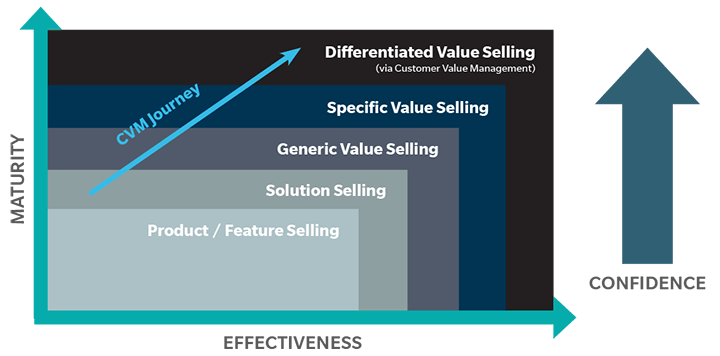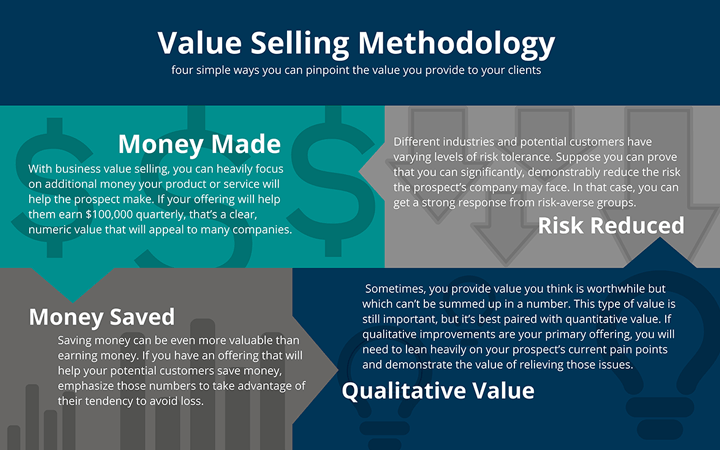How to Build a Strong Value Selling Framework for Your Sales Organization

The days of generic sales pitches are gone for good. Modern buyers now demand customized proposals from sales representatives who prioritize the specific needs of each prospect.
Take note of these findings from the 2018 CSO Insights Study conducted by the Miller Heiman Group:
- 70% of buyers have identified their requirements and know they want to buy something before even speaking to a salesperson.
- 92% of buyers expect a value proposition early in the sales process.
- Less than one-third of buyers perceive a significant difference between various vendors.
The solution — value selling, a distinct sales method that places the buyer and their business at the heart of the sales journey. Rather than describing how a product can address "issues like yours," the value seller zeroes in on each prospect's unique challenges. They demonstrate how their solution assists with addressing a specific pain point and the extent of its impact on a company’s bottom line.
Value selling is highly effective but requires a robust framework to succeed. In this article, you will discover the concept of a value-selling framework, its components, and how to establish one within your organization.
First Things First — What Is a “Sales Framework?”
Before we make a case for the importance of a value-selling framework, let's avoid the pitfall of impenetrable jargon. What do we even mean by “sales framework?”
Sales is a complex process that involves identifying potential customers, nurturing relationships, and closing deals. To be successful, sales professionals need a clear and effective roadmap for navigating this process. This is where a sales framework comes in. In this article, we will answer the question, "What is a sales framework?" and explore its importance in the sales process.
A sales framework is a structured approach to selling that outlines the steps involved in the sales process. It provides a clear roadmap for sales professionals to follow, helping them to be more efficient, effective, and consistent in their sales efforts. Sales frameworks can take many forms, but they typically include the following key components:
- Prospecting: This involves identifying potential customers who may be interested in your product or service. This may involve researching and analyzing data to identify target markets and individuals.
- Qualifying: Once potential customers have been identified, sales professionals must determine whether they are a good fit for their product or service. This involves assessing the customer's needs, budget, and decision-making process.
- Needs Analysis: In order to provide a solution that meets the customer's needs, sales professionals must gain a deep understanding of their customer's goals, challenges, and pain points. This may involve asking probing questions, listening actively, and analyzing data.
- Presentation: After understanding the customer's needs, sales professionals must present a solution that meets those needs. This may involve a product demonstration, proposal, or another form of communication.
- Handling Objections: Customers may have objections or concerns about the proposed solution. Sales professionals must be prepared to address these objections and provide solutions to alleviate any concerns.
- Closing: The sales professional must close the deal once objections have been addressed and the customer is satisfied with the proposed solution. This involves finalizing the terms of the sale and obtaining the customer's commitment.
- Follow-up: After the sale, sales professionals must follow up with the customer to ensure satisfaction and maintain the relationship.
A well-defined sales framework can help sales professionals to be more efficient, effective, and consistent in their sales efforts. It provides a clear roadmap for navigating the sales process, helping sales professionals to stay on track and meet their sales goals. In addition, a sales framework can help identify improvement areas, allowing sales teams to refine their approach and optimize their sales process over time.
The Importance of a Value Selling Framework
Value selling is more complex than previous selling approaches. Traditional sales models usually start with talking to your prospects, but buyers’ needs have become more nuanced.

A long time ago, when sales as we know it was born, sales reps broadcast the features of a product through product and feature selling. As prospects’ needs became more complex, this evolved to solution selling. This approach targeted pain points, but those pain points weren’t necessarily specific to the prospect.
When generic value selling entered the picture, it was still one-size-fits-all. Sales representatives told prospects what others had achieved using the same solutions, hoping that the prospect would want what their competitors had.
Specific value selling is more mature. This is today’s standard approach to value selling, in which you research a prospect’s needs and create a targeted presentation, showing the prospect exactly how much your offering will improve their business.
You can drill down even deeper and get more sophisticated with differentiated value selling, quantifying value for a specific project. You show the prospect their options for allocating budget and driving results, focusing on how your solution will get the prospect closer to their goals.
You need a structured framework to create a specific or differentiated value selling proposition. You and your team need to know how to create this proposition, what it should entail, and how to bring it to the client.
Value Selling vs. Other Selling Methodologies
Value Selling vs. Solution Selling
Solution selling focuses on identifying customer problems and providing tailored solutions to resolve those issues. While this approach is customer-centric, it does not always emphasize the value of the offered product or service.
On the other hand, value selling is rooted in understanding the customer's needs and demonstrating how a product or service provides value in meeting those needs. The emphasis is on showing how the benefits of a solution outweigh the costs, resulting in a greater return on investment (ROI) for the customer. This creates a stronger and more compelling sales argument, leading to increased conversions and customer satisfaction.
Value Selling vs. Feature Selling
Feature selling, as the name suggests, is centered around promoting the features of a product or service. While these features may be impressive, they often do not effectively communicate the value or benefits a customer will experience.
Value selling shifts the focus to the outcomes that customers can achieve by using a product or service. By showcasing tangible value, such as cost savings, increased efficiency, or improved productivity, customers are more likely to see the importance of investing in your solution.
Value Selling vs. Consultative Selling
Consultative selling involves building trust and rapport with the customer by offering expert advice and guidance throughout the sales process. This approach can be effective in building long-term relationships; however, it can fall short when demonstrating the value of a product or service.
Value selling incorporates consultative selling techniques while also emphasizing the value proposition. This combination ensures that customers trust your expertise and see the direct benefits of your product or service, making it an easier decision to buy.
Value Selling vs. Challenger Selling
Challenger selling is based on the premise that salespeople should challenge customers to think differently about their problems and solutions. While this can lead to thought-provoking conversations, it can sometimes create friction and confrontation, hindering sales.
Value selling maintains a customer-centric approach by focusing on understanding customer needs and presenting the value of a product or service. By building a case for your solution's value, you can create a more persuasive sales argument without the potential drawbacks associated with challenger selling.
Elements of a Strong Sales Framework
At its core, value selling looks to create a match between a buyer and a seller. Your job as the seller is to highlight the importance of that match, focusing on specific problems the prospect needs to solve.
Your Unique Selling Proposition
This is the first element of your value selling framework. It encompasses what makes you superior to the competition and why the prospect should choose you. You’ll adjust it based on the needs of each individual prospect, but you need a core message from which to work.
To develop your USP, you must find out what problems you solve better than anyone else. Find out where you innovate and specify how to translate that innovation into customer adoption.
Start by thinking about your product-market fit. Identify the main problems that your product or service solves and how it solves them.
Next, bring those problems to companies and decision-makers in your target audience. Find out which of your identified problems represents the biggest pain point. Ask what solutions are currently available.
Use those answers to develop your unique selling proposition. It should answer the question “Why should we choose you?” and be adaptable to suit an individual prospect’s needs.
Most importantly, it should be something you and your team understand and can buy into fully. A prospect never will if you don’t believe in your USP completely.
Knowledge Gained from Research
Your job as a value seller is to match your USP to the client’s needs. You’ll gather much of this information by talking to the client, but you still need to go in prepared with background knowledge.
That means finding out the prospect’s:
- Mission and objectives
- Current business focus
- Recent events (product releases, mergers and acquisitions, changes in leadership, etc.)
- Strengths and advantages in the market
- Weak spots and vulnerabilities
- Competitor strengths
Sales professionals who employ a value selling approach for the first time are often surprised at how much information is publicly available. Company websites often have news pages and even downloadable revenue reports.
Research your contact at the company as well. Find out what they do, where their experience lies, and what their specific pain points are. LinkedIn is a great resource because it gives you detailed information, including training and publications.
Identified Value
Effective value selling propositions today use numbers and concrete examples. These usually fall into one of four categories:
- Money earned: How much more revenue can the prospect earn with your offering? Give them a figure.
- Money saved: Cost control can be even more valuable than increased revenue. When a prospect is loss-averse, focus on how much your offering could save them per year or quarter.
- Risk reduction: Quantifying risk reduction is also valuable for loss-averse prospects. If the risk is a major pain point for your prospect, explain and quantify how your offering reduces that risk.
- Qualitative value: Numbers sell best, but don’t hold back on a great value proposition because you can’t measure it. Instead, present qualitative points as a supplement to your measurable value proposition.

As you might guess, this step involves intensive work. To quote benefits — this product will save your team six hours a week and improve efficiency by 5% — you need to know a lot about your prospect and how their operations would interact with your product.
Fortunately, you can tie much of this research into the sales conversation. When they identify a pain point, ask for details. Do they spend too much time on invoicing? Ask how long it takes and what other solutions they’ve tried. Find out how long those other processes take and how much shorter yours would be.
The more you know about the prospect’s needs, the more detail you can give them about your value proposition. Meanwhile, you deepen your relationship with the prospect, becoming an advocate who’s dedicated to their success.
A Business Case
Your identified value is only part of the complete value selling proposition. Decision-making teams will have questions, and your team needs to be ready with a credible business case.
To justify an expense, decision-makers will want to track your quoted return on investment or cost reduction. Expect to share the statistics you used to calculate your value quote, providing as many sources as possible.
Your business case should also include control statistics that showcase the cost of not taking action. For example, if a process would cost $X with your solution, highlight that it would cost $X+Y with the current system in place.
A well-compiled business case will do three things:
- Create consensus on what justifies a purchase
- Move your solution up the buyer’s priority list
- Position you as a trusted authority and ally
Your business case will also be a discovery tool for your team. If it lands well, you know you’ve found what matters to the prospect.
Listening More Than You Talk
Other approaches to sales focus on explanation and exposition. Unfortunately, that’s part of how sales earned a reputation for being pushy. You don’t know what information prospects need until you’ve asked for it.
A good value-selling framework will focus on listening to the prospect. Every value point should come out of a question you've asked them, such as:
- How do you measure the impact of changes in your business?
- How much do your current solutions cost?
- What are the shortcomings of those solutions?
- How are your current challenges affecting your business?
The prospect’s answers will tell you two things:
- What they need your offering to do
- What goals and achievements matter to them
People make decisions based on their values, and B2B is no exception. It might look on paper like a company needs to solve Problem A, but if the prospect continuously talks about Problem B, that’s where you need to focus your energy.
Quality Sales Conversations
Value selling may require more work than traditional selling techniques, but it gets better and bigger results. You can close more deals, agree on better terms, and build stronger relationships — all because you know more about the client and can target your pitch with the knowledge you’ve gained.
The key is to focus on quality over quantity. Instead of aiming for a certain number of touchpoints, maximize the value of every interaction. Write fewer emails but spend more time on each one, ensuring it provides value to the prospect.
Remind your team that they're playing the long game. Hours of research might yield a single piece of data for your value proposition — this feature can increase your average order value by 5% — but the impact of that statistic could land you a sale.
A Teaching Focus
A salesperson's goal is to convince the prospect to buy. They use persuasive language and focus on the function of the offering. They may discuss benefits and pain points, but it all goes back to the product.
Value sellers genuinely believe the product will sell itself when the prospect realizes its use. They see themselves more as educators, explaining the offering’s functionality related to their prospect's needs.
Build your value selling framework around the concept of the salesperson as a helpful guide. Imagine the prospect has come to you directly with their pain point, asking for help. What product qualities can you highlight as solutions?
Slide presentations and videos are great tools, but they require the salesperson themselves to be the ultimate resource. It’s also important to ask lots of questions, as any good teacher would.
Drill down to find what the prospect's biggest needs and struggles are. Then, guide them toward your product as the ideal solution, always bringing the conversation back to value.
Relationship and Trust at the Core
Value selling is so technical and data-focused that some people forget it’s ultimately about becoming the prospect’s ally. When you enter a sales situation as a value seller, you don’t start by selling the product. You start by offering yourself — your knowledge and expertise — as a resource for the prospect.
If you can earn the client’s trust, that relationship will drive the value-selling process forward. Retain your credibility because it’s almost impossible to get back once you’ve lost it.
When you don’t know the answer to a question, tell the prospect you’ll find the answer as soon as possible. Then, file that answer away so you can offer it quickly when another prospect asks.
Value selling may be more sophisticated than many other techniques, but one thing remains true — prospects buy from salespeople they trust.
Building a Presentation
Your value selling framework will be the scaffolding for every presentation you make. The content has to be unique, so the structure is your consistency.
1. Acknowledge the prospect’s pain points
If possible, quote some facts the prospect has given you. You’ve mentioned that running your digital marketing costs you $X per year.
2. Give a detailed explanation of your business value directly linked to their pain points
This is the time to reference a business case or value proposition. This software can save you $Y per quarter and free up X staff hours.
3. Have a brief price discussion with a focus on value and ROI
Try to show that your solution's benefits exceed the cost. If you can’t show that explicitly, continue emphasizing value, so the prospect sees the price as fair.
Slide presentations are great ways to move through all three points while leaving room for prospect questions.
Implementing Your Value Selling Framework
Successful implementation of this new sales methodology requires three things:
- Integration into the entire sales process. Value selling isn’t just a strategy; it’s a way of life. It will change every step of your sales process. You need to be ready to rework and reframe that process accordingly.
- Getting buy-in from team and organization leaders. Your C-suite needs to believe in value selling and your USP just as much as your salespeople. If necessary, value-sell it to them.
- Linking value selling to other teams and functions. The product development team needs to know your process to help you learn more about what you’re selling. The marketing team should know what kind of experience their leads are moving toward. The more you connect value selling to other things, the better.
This transformation process can take time, especially if your current sales methodology is in place for a while. Consider introducing the framework via a formal change management process, like the classic unfreeze-transform-refreeze approach by 20th-century innovator Kurt Lewin:
- Unfreeze: Increase awareness and create urgency for change. Show your stakeholders why value selling is so important to their business success. Start sales training in value selling so representatives can experience its value firsthand.
- Transform: Implement the value selling framework in your interactions with customers. Help representatives follow the framework, providing coaching where necessary. Highlight successes and record results.
- Refreeze: Reinforce value selling as your new sales methodology. Measure adoption rates and analyze results. Refine the process as necessary based on what works for your customer base. Highlight successes and help representatives learn from their colleagues’ triumphs.
Your ultimate goal is to solidify your team’s use of the value-selling framework. Once it’s integrated into the organization’s sales process, each team member can adapt it based on their needs and the prospect’s.
Testing, Iterating, and Improving your Value Sales Framework
Implementing your new value-based sales framework isn’t the end of the story. You have to test the framework and improve it across multiple iterations continually.
The following steps outline how to refine your value selling framework effectively:
- Establish a baseline: Before you start testing and iterating your value selling framework, it's essential to have a clear understanding of your current sales process. Document each sales funnel stage, including lead generation, qualification, proposal, negotiation, and closing.
- Set clear objectives: Define the goals you aim to achieve with your value selling framework. These objectives could include increased close rates, shorter sales cycles, higher customer satisfaction, or increased average deal size.
- Develop hypotheses: Identify areas of improvement within your value selling framework and develop hypotheses on how adjustments could lead to better outcomes. For example, you might hypothesize that emphasizing ROI during the proposal stage could lead to a higher close rate.
- Test your hypotheses: Implement your identified changes and monitor their impact. This might involve adjusting your sales pitch, incorporating new value-driven materials, or refining your qualification process. Be sure to provide training and support to your sales team during this phase.
- Measure results: Track key performance indicators (KPIs) related to your objectives, such as close rates, customer satisfaction scores, or the length of the sales cycle. Analyze these metrics to determine the effectiveness of your adjustments.
- Gather feedback: Solicit feedback from your sales team and customers to gain insights into the effectiveness of your value selling framework. This feedback can help identify areas for improvement and potential new hypotheses to test.
- Iterate and refine: Based on the data and feedback collected, refine your value-selling framework accordingly. Repeat the testing and measurement process to optimize your sales approach continually.
- Foster a culture of continuous improvement: Encourage your sales team to embrace an iterative mindset and be open to change. Provide ongoing training and support to ensure your team can adapt and improve the value-selling framework.
- Benchmark against industry best practices: Stay informed about industry trends and best practices in value selling. Evaluate your framework against these practices to identify areas for further improvement.
- Review and adjust periodically: Regularly assess the performance of your value-selling framework to ensure its continued effectiveness. As market conditions and customer needs evolve, you may need to adjust to stay competitive and maintain a strong value proposition.
Summary
A clear and useful value-selling framework is the key to success in today’s market. Your framework should be explicit but flexible. It should encourage your team to learn as much as possible about each prospect and clearly explain how your offering provides value.
Value selling will always involve time investment on your team’s part, but the results are worth it, and the right tools can help. If you’re ready to start value selling, look at ValueCloud®, a dynamic customer value management system.
ValueCloud® will give you the tools to create polished, professional value propositions. It includes several advanced tools, including
- A Hypothesis Builder, which lets you and your colleagues create quantifiable value propositions in less than a minute
- A Business Case Builder, which allows your team to create business cases that engage and compel buyers based on relevant data
- A Value Realization Tracker, which lets you follow up with buyers and help them get the results you discussed
Learn more about ValueCloud® today, and see what value selling can do for your organization.

 ValueCloud
ValueCloud
.png?width=118&height=76&name=Rectangle%20(3).png) ValueCloud Ignite
ValueCloud Ignite
.png?width=92&height=92&name=Rectangle%20(4).png) Free Assessment
Free Assessment
.png?width=100&height=100&name=Rectangle%20(5).png) Watch a Demo
Watch a Demo
.png?width=82&height=96&name=Rectangle%20(6).png) Value Calculator
Value Calculator

.png?width=62&height=51&name=Group%2010%20(1).png) Marketing
Marketing
 Sales
Sales
 Customer Success
Customer Success
 Engage Prospects
Engage Prospects
 Win Deals Faster
Win Deals Faster
 Retain Customers
Retain Customers
.png?width=62&height=62&name=Rectangle%20(8).png) Adopt and Scale
Adopt and Scale
.png?width=54&height=54&name=Rectangle%20(9).png) Cybersecurity
Cybersecurity
 Healthcare
Healthcare
.png?width=54&height=54&name=Rectangle%20(10).png) IT & Software
IT & Software




